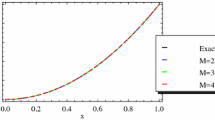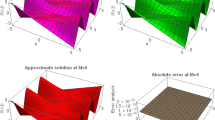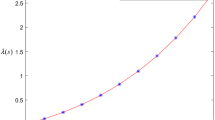Abstract
In this work, an extension of the algebraic formulation of the Shannon wavelets for the numerical solution of a class of Volterra integro-differential equation is proposed. Our approach is based on the connection coefficients of the Shannon wavelet and collocation method for constructing the algebraic equivalent representation of the problem. Also, the Shannon approximation is applied to solve one type of nonlinear integral equation arising from chemical phenomenon. An analysis of error for the problem is given. The obtained numerical results show the accuracy of the presented method.
Access provided by CONRICYT-eBooks. Download chapter PDF
Similar content being viewed by others
Keywords
2010 AMS Math. Subject Classification
1 Introduction
Integral, integro-differential, ordinary and fractional differential equations are used in modelling problems of engineering and science fields, including mathematical biology, electromagnetic theory, potential theory and chemical engineering, see [1, 2, 5, 7, 8, 11, 14] and references therein.
The main purpose in this article is to develop and to provide a numerical algorithm based on the coefficients of the Shannon wavelets for the following form of integro-differential equation
where \(\Gamma _{i}\) are constants, k and f are given functions and u(x) is a solution to be determined. Noting that for \(\Gamma _{1}=0\), (1) be transformed to integral equation.
Over the past few decades, the numerical solvability of these type of equations has been studied intensively by many authors, such as Chebyshev spectral solution [6], rationalized Haar functions [12] and Sinc-Legendre collocation method [13].
Wavelets are very powerful and useful tool in data compression, signal and operator analysis. The real part of the harmonic wavelets is Shannon wavelets. These wavelets can be used to study frequency changes as well as oscillations in a small range time interval [4].
This paper is organized as follows: Sect. 2 introduces some basic definitions and preliminaries of the Shannon wavelets. We derive formulas for a class of IDEs and give a numerical scheme based on proposed method in Sect. 3. Error analysis of our method is considered in Sect. 4. Finally, in Sect. 5, we report several numerical experiments to clarify the efficiency and accuracy of the proposed method.
2 Preliminary Definitions
Here, we give some basic definitions of the Shannon wavelets family [4, 9]. The Sinc function is defined on the whole real line by:
The Shannon scaling functions and mother wavelets can be defined as:
we recall the following theorem from [3]:
Theorem 2.1
If \(u(x)\in L_{2}(\mathbb {R})\), then
with
Using a finite truncated series of the above theorem, we can define an approximation function of the exact solution u(x) as follows:
The nth derivatives of u(x) in terms of the Shannon wavelets can be written as (see e.g. [9] for further details):
on the other hand, we have the following relations [4]:
Therefore, (6) rewritten as:
where
which \(\lambda ^{(n)}_{kh}\) and \(\gamma ^{(n)jj}_{kh}\) are known as the connection coefficients.
Moreover, it is
3 Numerical Treatment of the Problem
In this section, we will obtain formulas for numerical solvability of (1), based on the previous results. We define an approximation function \(u^{'}(x)\) as follows:
By taking \(n=1\) in (10), (11) and using simple computations, we obtain the following relations for \(\lambda ^{(1)}_{kh}\) and \(\gamma ^{(1)jj}_{kh}\):
and due to (12), we can write \(\gamma ^{(1)jj}_{kh}=2^{(j-1)}\gamma ^{(1)11}_{kh},\) for \(j>1\).
Now, we are ready to apply the obtained results for constructing the algebraic equivalent presentation of (1). Equation (1) can be rewritten as:
by substituting (5), (13) and (14) in the above equation, we have:
and by rearranging the above equation based on unknowns \(\alpha _{k}\) and \(\beta _{j,k}\), we get
We may set
therefore, we can write (15) as:
For obtaining \((2N+1)(2M+2)\) unknowns \(\alpha _{k}\) and \(\beta _{j,k}\), we take \(x=x_{i}\) for \(i=1,\ldots ,(2N+1)(2M+2)-1\), where \(x_{i}\) be collocation points. So, we have
On the other hand, \(u(a)=a_{0}\) can be written as
According to above equations, a system of \((2N+1)(2M+2)\) linear equations is obtained. By solving the resulting system, unknowns \(\alpha _{k}\) and \(\beta _{j,k}\) can be determined and so the approximate solution u(x) will be obtained.
The following algorithm summarizes our proposed method:

4 Error Analysis
In this section, we will provided a convergence analysis of the numerical algorithm for a class of integro-differential equation (1).
Theorem 4.1
Assume that \(\widetilde{u}(x)\) be the approximate solution of Eq. (1). If \(u^{(1)}(x)\in L_{2}(\mathbb {R})\), then the obtained approximation solution of the proposed method converges to the exact solution, where \(\alpha _{k}\) and \(\beta _{j,k}\) are given in Theorem 2.1.
Proof
Note that
Due to [9], the following relation holds
or
according to definitions of \(\alpha _{k}\) and \(\beta _{j,k}\) in Theorem 2.1 and Eqs. (7) and (8), for \(n=1\) above relation can be written as
which proves the theorem.\(\square \)
Theorem 4.2
Let \(u^{(1)}_{M}(x)\) be the first-order derivative of the approximate solution of Eq. (1), then there exist constants \(C_{1}\) and \(C_{2}\) independent of N and M, such that
where \(C_{1}=Max\{|\sum _{k} \sum _{h} \lambda _{kh}^{(1)}|\}\), \(C_{2}=Max\{|\sum _{k} \sum _{h} \gamma _{kh}^{(1)jj}|\}\) and M, N refer to the given values of j and k.
Proof
See [10].
Detailed analysis of the proof of this theorem can be found in [9, 10], so we refrain from going into details.
5 Numerical Results
In this section, several test problems are considered to demonstrate the accuracy of the proposed method.
Example 5.1
Consider the following equation
with the exact solution \(u(x)=x\).
Example 5.2
Consider the following equation
with the exact solution \(u(x)=e^{x}\).
The computational results of Examples 5.1 and 5.2 have been reported in Tables 1 and 2, to show the accurate solution of mentioned algorithm. The exact and approximate solution of these examples for different values of M and N are compared in Figs. 1 and 2.
Exact and approximate solution of Example 5.1 for different values of M and N using presented method
Exact and approximate solution of Example 5.2 for different values of M and N using presented method
Example 5.3
Consider the following equation with the exact solution
Examples 5.3 and 5.4, which are obtained by taking \(\Gamma _{1}=0\), are integral equations. The numerical results of these examples are reported in Table 3. Also, Figs. 3 and 4 show the exact and approximate solution of Examples 5.3 and 5.4 for M \(=\) 2 and N \(=\) 3, respectively.
Exact and approximate solution of Example 5.3 for M \(=\) 2 and N \(=\) 3 using presented method
Exact and approximate solution of Example 5.4 for M \(=\) 2 and N \(=\) 3 using presented method
Example 5.4
Consider the following equation
with the exact solution \(u(x)=\cos (x)\).
Example 5.5
Consider the following equation
with the exact solution \(u(x)=\dfrac{1}{1+x}\). This problem is a nonlinear Hammerstein integral equation which arising from chemical phenomenon. By choosing Shannon scaling functions, Example 5.5 has been solved. The reported results in Table 4 show that the Shannon approximation has produced highly numerical results. Good numerical results can be achieved by additional numerical experiments (e.g. with \(N\ge 2\)). This problem has been solved by \(u(x)\simeq \sum _{k=1}^{2^{N}}\alpha _{k} \varphi _{N,k}(x)\).
6 Conclusions
In this present work, we applied an accurate and efficient method for solving a class of IDEs. We consider a special class of IE, which is a quantum chemistry, by the Shannon scaling functions. Our obtained results are in a good agreement with the exact solutions and are given to demonstrate the applicability of our proposed method.
References
R.P. Agarwal, D.O. Regan, Ordinary and Partial Differential Equations (Springer, Berlin, 2009)
A.D. Boozer, Advanced action in classical electrodynamics. J. Phys. A: Math. Theor. 41 (2008)
C. Cattani, Connection coefficients of Shannon wavelets. Math. Model. Anal. 11(2), 117–132 (2006)
C. Cattani, Shannon wavelets theory. Math. Probl. Eng. Article ID 164808, 1–24 (2008)
M. Dehghan, F. Shakeri, Solution of an integro-differential equation arising in oscillating magnetic fields using He’s Homptopy perturbation method. Prog. Electromagn. Res. 78, 361–376 (2008)
G.N. Elnagar, M. Kazemi, Chebyshev spectral solution of nonlinear Volterra-Hammerestein integral equations. J. Comput. Appl. Math. 76, 147–158 (1996)
M.A. Fariborzi Araghi, Gh. Kazemi Gelian, Numerical solution of integro-differential equations based on double exponential transformation in the Sinc-collocation method. App. Math. Comp. Intel. 1, 48–55 (2012)
J.M. Machado, M. Tsuchida, Solution for a class of integro-differential equations with time periodic coefficients. Appl. Math. E-Notes 2, 66–71 (2002)
K. Maleknejad, M. Attary, An efficient numerical approximation for the linear class of Fredholm integro-differential equations based on Cattani’s method. Commun. Nonlinear. Sci. Numer. Simulat. 16, 2672–2679 (2011)
K. Maleknejad, M. Hadizadeh, M. Attary, On the approximate solution of Integro-differential equations arising in oscillating magnetic fields. Appl. Math. 5, 595–607 (2013)
I. Podlubny, Fractional Differential Equations (Academic Press, San Diego, 1999)
M. Razzaghi, Y. Ordokhani, Solution of nonlinear Volterra-Hammerstein integral equations via rationalized Haar functions. Math. Probl. Eng. 7, 205–219 (2001)
A. Saadatmandi, M. Dehghan, M.R. Azizi, The Sinc-Legendre collocation method for a class of fractional convection-diffusion equations with variable coefficients. Commun. Nonlinear. Sci. 17, 4125–4136 (2012)
Sh. Wang, Dislocation equation from the lattice dynamics. J. Phys. A: Math. Theor. 41 (2008)
Author information
Authors and Affiliations
Corresponding author
Editor information
Editors and Affiliations
Rights and permissions
Copyright information
© 2017 Springer Nature Singapore Pte Ltd.
About this chapter
Cite this chapter
Attary, M. (2017). An Extension of the Shannon Wavelets for Numerical Solution of Integro-Differential Equations. In: Ruzhansky, M., Cho, Y., Agarwal, P., Area, I. (eds) Advances in Real and Complex Analysis with Applications. Trends in Mathematics. Birkhäuser, Singapore. https://doi.org/10.1007/978-981-10-4337-6_12
Download citation
DOI: https://doi.org/10.1007/978-981-10-4337-6_12
Published:
Publisher Name: Birkhäuser, Singapore
Print ISBN: 978-981-10-4336-9
Online ISBN: 978-981-10-4337-6
eBook Packages: Mathematics and StatisticsMathematics and Statistics (R0)








